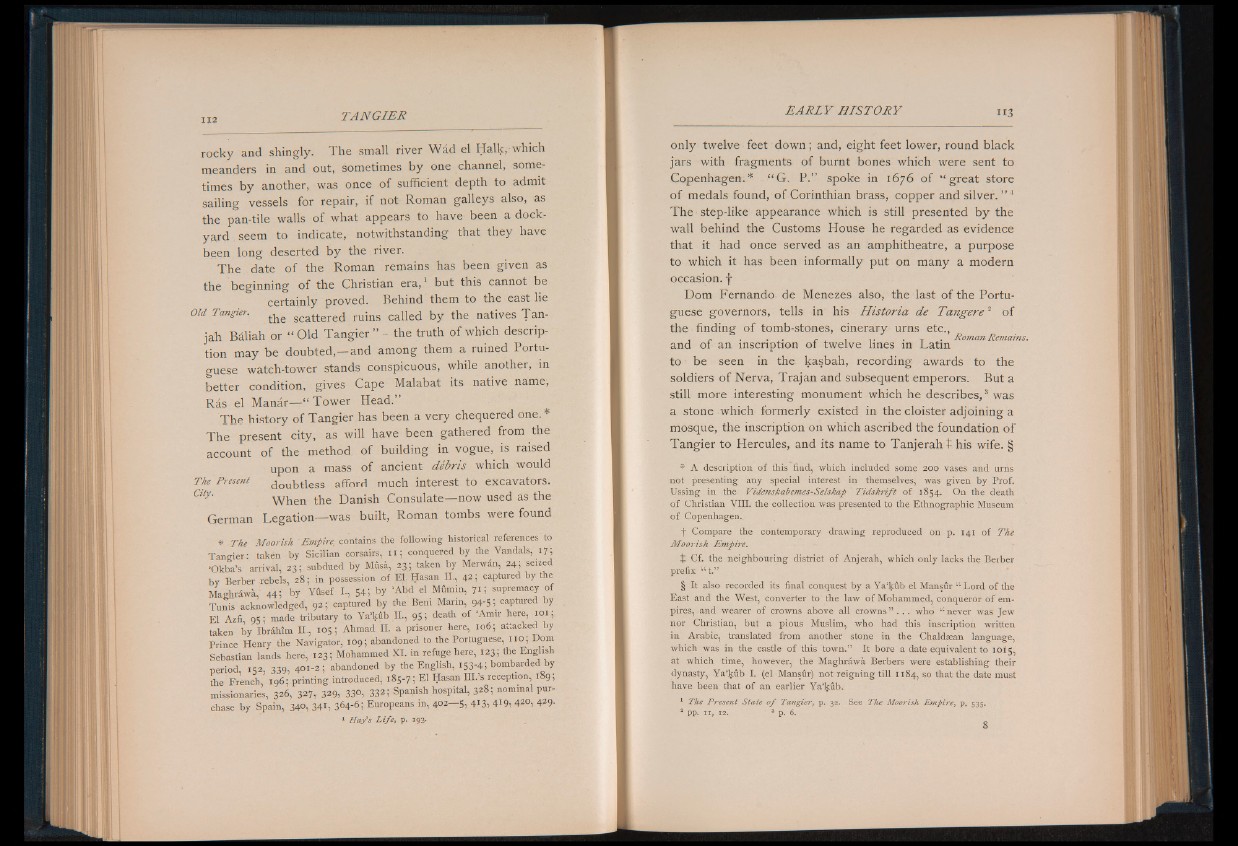
rocky and shingly. The small river Wad el Halk, which
meanders in and out, sometimes by one channel, sometimes
by another, was once of sufficient depth to admit
sailing vessels for repair, if not Roman galleys also, as
the pan-tile walls of what appears to have been a dockyard
seem to indicate, notwithstanding that they have
been long deserted by the river.
The date of the Roman remains has been given as
the beginning of the Christian era,1 but this cannot be
certainly proved. Rehind them to the east lie
Old Tangier. the scattered ruins called by the natives Tanjah
Bâliah or “ Old Tangier ” - the truth of which description
may be doubted,— and among them a ruined Portuguese
watch-tower stands conspicuous, while another, in
better condition, gives Cape Malabat its native name*,
Ras el M a n a r— “ Tower Head.”
The history of Tangier has been a very chequered one. *
The present city, as will have been gathered from the
account of the method of building in vogue, is raised
upon a mass of ancient débris which would
The Present doubtiess afford much interest to excavators.
When the Danish Consulate— now used as the
German Legation— was built, Roman tombs were found
* The Moorish Empire, contains the following historical references to
Tangier- taken by Sicilian corsairs, n ; conquered by the Vandals, 17;
‘Okba’s arrival, 23; subdued by Mûsà, 23; taken by Merwân, 24; seized
by Berber rebels, 28; in possession of El, Hasan II., 42; captured by the
Maghrâwà, 44; by Yûsef I., 545 by ‘Abd el Mumin, 715 supremacy of
Tunis acknowledged, 92 ; captured by the Beni Marm, 94-5 ; captured by
El Azfi, 95; made tributary to Ya’kûb IL, 95; death of ‘Amir here, 101,
taken by Ibrahim H, 105; Ahmad II. a prisoner here, 106; attacked by
Prince Henry the Navigator, 109; abandoned to the Portuguese, n o ; Dom
Sebastian lands here, 123; Mohammed XI. in refuge here, 123; the English
period 152, 339, 401-2; abandoned by the English, 153-4; bombarded by
the French, 196; printing introduced, 185-7; El Hasan IH.’s reception, 189,
missionaries, 326, 327, 329, 330, 332; Spanish hospital, 328; nominal purchase
by Spain, 340, 34R 304-6 ; Europeans in, 402— 5, 4131 419, 420, 429.
1 Hay's L if e , p. 193.
only twelve feet down ; and, eight feet lower, round black
jars with fragments of burnt bones which were sent to
Copenhagen.* “ G. P.” spoke in 1676 of “ great store
of medals found, of Corinthian brass, copper and silver.” 1
The step-like appearance which is still presented by the
wall behind the Customs House he regarded as evidence
that it had once served as an amphitheatre, a purpose
to which it has been informally put on many a modern
occasion, f
Dom Fernando de Menezes also, the last of the Portuguese
governors, tells in his Historia de Tangere2 of
the finding of tomb-stones, cinerary urns etc.,
AT / rPITJ/Tilt f
and of an inscription o f twelve lines in Latin
to be seen in the kasbah, recording awards to the
soldiers of Nerva, Trajan and subsequent emperors. But a
still more interesting monument which he describes,3 was
a stone which formerly existed in the cloister adjoining a
mosque, the inscription on which ascribed the foundation of
Tangier to Hercules, and its name to Tanjeraht his wife. §
* A description of this find, which included some 200 vases and urns
not presenting any special interest in themselves, was given by Prof.
Ussing in the Videnskabemes-Selskap Tidskrift of 1854. On the death
of Christian VIII. the collection was presented to the Ethnographic Museum
of Copenhagen..
.■f Compare the contemporary drawing reproduced on p. 141 of The
Moorish Empire.
f Cf. the neighbouring district of Anjerah, which only lacks the Berber
prefix cct.”
§ It also recorded its final conquest by a Ya5kub el Mansur u Lord of the
East and the West, converter to the law of Mohammed, conqueror of empires,
and wearer of crowns above all crowns ” . . . who pnever was Jew
nor Christian, but a pious Muslim, who had this inscription written
in Arabic, translated from another stone in the Chaldsean language,
which was in the castle of this town.” It bore a date equivalent to 1015,
at which time, however, the Maghrdwa Berbers were establishing their
dynasty, Ya’kub I. (el Mansur) not reigning till 1184, so that the date must
have been that of an earlier Ya‘kub.